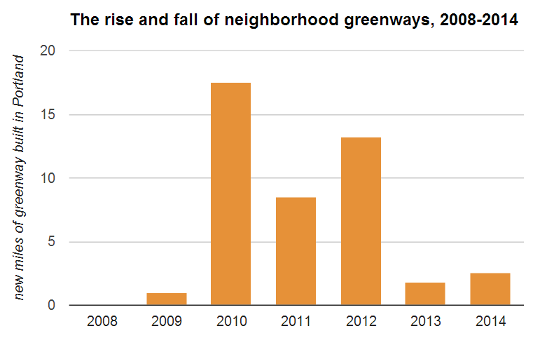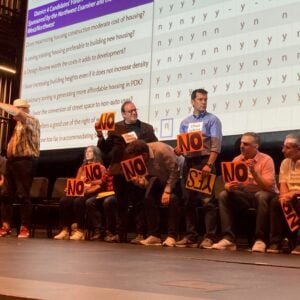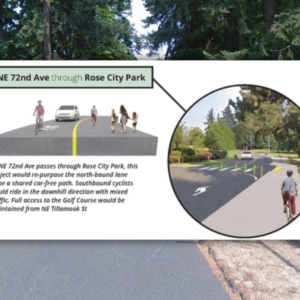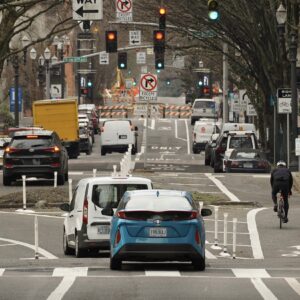
diverters to reduce volumes, signals to cross busy
streets and sharrow markings and signs to guide users
through the city.
(Photo: J.Maus/BikePortland)
As cities from Seattle to St. Louis to Louisville work to duplicate Portland’s “neighborhood greenway” concept on their residential streets, Portland is giving its trend-setting system a closer look.
A team of experts in the city’s transportation bureau will spend part of their time in the next few months looking closely at trends in how people use the system while biking, walking and driving.
A public report is due in early 2015.
City Active Transportation Division Manager Margi Bradway said Wednesday that the goal of this report, which she predicted will receive national attention once it’s complete, is to inform an upcoming policy conversation here in Portland about how best to keep improving the greenway system.
“I’m excited about the results — I don’t think we’ve actually done this before,” Bradway said. “We haven’t been able to pause and know where we’re at.”
Advertisement
The decision comes after the local advocacy group BikeLoudPDX and other Portlanders called attention this summer to what they described as unacceptably high auto traffic on SE Clinton Street, which shares some but not all characteristics of newer greenways like NE Going or SE 53rd Avenue.
Bradway said she looks forward to a public debate next year over where future investments should go, but is focused for now purely on gathering the data that’ll inform that debate.
“I appreciate all the attention it’s brought to Clinton,” Bradway said. “I think it’s important. But I’m trying to push my staff into not being reactive. I want to come up with a plan, but I want to take a system-wide look.”
Portland Bicycle Planning Coordinator Roger Geller and Traffic Safety Specialist Greg Raisman, the co-creator of the neighborhood greenway concept, will be among those on the fact-finding team.
The project is one of Bradway’s first major initiatives in her key city position, which she accepted in June.
As we reported in February, Portland mostly stopped expanding its greenway network last year, citing a lack of available local funding as it shifted resources to fog-seal pavement maintenance and other goals.
The Portland Street Fund under discussion at City Hall this afternoon would, if approved, dedicate 3 percent of its revenue to the neighborhood greenway network, enough to resume greenway network expansion at the rates seen in 2010, 2011 and 2012.







Thanks for reading.
BikePortland has served this community with independent community journalism since 2005. We rely on subscriptions from readers like you to survive. Your financial support is vital in keeping this valuable resource alive and well.
Please subscribe today to strengthen and expand our work.
If I recall correctly, the Greenway system was supposed to be the “low hanging fruit” that was easier (politically and economically) to build than real separated bike infrastructure on main streets. What does it mean that even this has stalled in Portland?
How much longer do we have to wait for the city to wake up, and build what we all agree is necessary?
It’s all about commuters from the burbs and freight bitching about access and speed. These folks have gotten an unfair share of our transportation funds. A city is a congested place, and congestion means slower speeds and less fatalities. We need to allocate much more of our funding to vision zero, road diets, bike/ped infrastructure, and increased density along commute corridors. The reason things stalled is because the Hales admin has always advocated “back to basics,” dog whistle politics for “ignore bikes, add lanes.” The Hales admin is the start of the decline. It should be obvious who his beneficiaries are.
We need more road diets, more bike lanes, slower cars and more density. None of Portland should be drive through. We must make place everywhere for our city to be equitible; that means funding multimodal over simply funneling cars at the maximum rate.
Claiming that Hales is the beginning of the decline is a bit alarmist, no?
The elimination of PBOT’s $900,000 annual budget for neighborhood greenway expansion happened, as I understand it, after Hales took office and took control of all the bureaus. But the amount of biking in the city hasn’t changed since 2008, when voters elevated Sam Adams from a transportation-focused, bike-friendly city commissioner to a scandal-burdened mayor.
Many other things were happening at that time. People from around the country started moving to Portland in large numbers in 2005, but in 2008 the region basically stopped building new homes for several years and we’re still 20,000 homes in the hole. This has led to rapid rent increases in bike-friendly areas, which is where people seem to be most enthusiastic about living.
Also, gas prices leveled off.
Also, TriMet started seriously cutting bus service, though it’s been clawing its way back.
Finally, the Portland area’s recession was significantly more painful than in most metro areas. This led to a round of pretty vicious self-loathing in the local media that attached itself (rightly or wrongly) to bikes and to Mayor Adams. (Our regional economy is now above average nationally, with the City of Portland leading the way.)
I think all of these factors have combined to cause Portland’s biking stagnation.
This makes sense. Blaming it all on Hales and claiming he is the beginning of a long decline is shortsighted and alarmist at best. Clearly Portland is still feeling the effects of the recession, but it’s obvious that the city is doing things to address most of the issues you listed. This will likely take a few years to fully realize the effects.
This is great news. We at BikeLoudPDX (for which this comment does not officially speak) and in some of the neighborhood groups have been discussing how to fix the greenways/bikeways, so that turning the stop signs doesn’t just turn them into additional minor arterials for car cut-through traffic. Some of the ideas we’ve discussed include:
* The current diverter policy isn’t working very well for greenways/bikeways:
– Current policy says, don’t install diverters unless there is more auto traffic per hour than a certain threshold
– This is actually a rather stupid way to do it, because it sets up diverters for conflict: Wait for a problem to appear, then install a solution that spreads the problem around to the adjacent streets, then wait for them to complain so it’s possible to then say “look, diverters don’t work, because people complain!”
* Instead, set urban form-based standards for traffic diverter installation:
– Diverters at all intersections of greenways/bikeways and arterials, to prevent cars from turning from arterials to greenways/bikeways in frustration when the traffic backs up on the arterial
– Additionally, diverters on greenways/bikeways between arterials. Minimum spacing between diverters, two blocks. Maximum spacing, ten blocks.
– Actual diverter placement should be context-sensitive, responsive to the completeness of the adjacent street grid, idiosyncrasies such as schools, parks and other super-blocks, neighbor and business concerns, etc.
* A solution for intersections of two or more greenways/bikeways needs to be developed, such as a traffic circle, that would allow bicycle traffic to move safely through the intersection in all directions without stopping (or indeed employing the use of a stop sign at all).
– Since we know bicycles have a relationship with stop signs that involves a policy of “don’t stop unless you have or want to,” they probably aren’t the best traffic control solution for this situation.
– A more appropriate one should be deployed.
* Retail and commercial uses on greenways/bikeways:
– This is a great idea, and we know it works. Look at the nodes of commercial up and down Clinton, Ankeny, etc.
– More of it should be allowed by right under the new Comp Plan update, as a way to activate these spaces, contribute to the twenty minute neighborhood concept, etc.
– As long as it’s context-sensitive, it could be a net asset to the city. Bike shops on bikeways! What a novel idea!
* Speed humps: Let’s get rid of this solution, or at least use it as the solution of last resort.
– Diverters should be used instead of speed humps, where possible
– Speed humps should only be deployed in those instances where diverters are, for whatever reason, actually impossible to install.
– See the latest research out of the Netherlands: speed humps on bikeways are, indeed, a no-no.
This!
This is spot on.
I suspect data will support.
please please let’s see diverters such that cyclists can safely and calmly roll in the age 8-80 model without yet another impatient driver. There really needs to be a reliably peaceful routes. Anecdotally, I witness tons of drivers skipping Mississippi to take the parallel cyclist designated route through the neighborhood.
Garlynn,
Many useful ideas, even though you avoid cost considerations. Diverters start off at around $10k per intersection (2 small islands) and a skinny median (20th/Harrison, or Going/15th) through an intersection is about $6k.
Diverters don’t slow down cars, and with fewer cars on a street those left have fewer deterrants to speed. What do you propose to achieve the target 20 mph operating speed on neighborhood greenways, if speed bumps are out? (maybe speed cushions?)(Do the Netherlands even have cars on their bikeways?)
I agree regarding context for diversion. For instance, much of east portland does not have a grid, so the streets the greenways end up on very often are the only way into a local neighborhood. Median barriers might work for the main road, but would only stop left turns and through moves (presuming no one u-turns).
Commercial on diverted local streets sounds good, but the bike traffic volumes would need to be high and year-round for a business to invest there, when a block or two away will be so many more commuters going by in cars.
Portland has typically gotten negative feedback regarding traffic circles, though the newer versions of mini-roundabouts, with the bike or car as the design vehicle and an operational goal of 15 mph, is already under consideration.
Paikiala, I believe that I heard that concrete planters, e.g. a certain Greenway intersection in N/NE Portland that I forget right now, are dramatically cheaper than islands or medians, and in the range of speed bumps. Is that in fact the case?
I believe that speed is generally a consideration when cars have longer than a few blocks between turns. That’s why I personally believe that diverters every 2 to 4 blocks is the ideal.
Personally, I would add a few things to Garlynn’s wish list:
*Speed bumps on every non-Greenway non-arterial cross street approximately 10 feet before the intersection with the Greenway. People driving straight through side-street stop signs at full speed or close to it is quite common and a huge comfort issue on greenways. This is the only thing I can think of that would have an impact on it at reasonable cost (raised crosswalks are the ideal solution but too expensive)
*Improved crossings at arterials – e.g. “crossbikes” – crosswalks for biking at faster than a walking speed – that have legal standing.
Between all of these things, greenways could become a facility approximately equally fast and comfortable to protected bike lanes on arterials. They still wouldn’t be as convenient as protected bike lanes (due to not having destinations on them in general) but they would be quite nice. Currently, our legacy greenways are barely better than the alternatives – and not even better than the alternatives at all in some cases.
The planter diverter at N Central and Tyler cost about $2500, but PBOT already had the planters. The cost to purchase them is estimated to be about $500 each (the concrete or fiberglass versions), so the ten at Central would add another $5k. A diagonal of planters may run about $4k, and there are likely lower cost and shorter life versions.
Another low cost form of diversion is alternating one-way streets with contra-flow bike lanes behind a parking lane. It could have islands to reinforce it, but it could be initiated with just paint and signs, maybe for $1,000 per block.
Thanks!!
Honestly, I personally don’t believe greenways are as good a solution for East Portland as they are for the rest of the Eastside. The side streets don’t connect, and the arterial streets are so giant they are very intimidating to cross without putting in HAWKs at every one. The arterial streets appear to be way oversized to me for the auto volumes they serve, so protected or buffered bike lanes on arterials seem like the main solution for biking in East Portland.
There will be a combination east of 205. The Greenways of the 110’s and 150’s will have sigificant “built in ” Diversion since to connect the disperate neighborhoods new paths through parks need to be built. The 130’s has off’set intersections at arterials that, for the time being at least, seem to me to lend itself to not need diversion but I do not know the traffic volume characters well.
That all said, these routes all meander due to the cul-de-sac nature of the growth pattern and in the long run protected on road facilities on 122nd and Division for example will need to be built. There is the room, unlike in most areas west of 205.
North-South greenways are not too difficult to find. It’s the east-west ones that end up being circuitous or expensive due to path construction.
Can you point me to the researching from the Netherlands about speed humps you’re citing?
thanks,
-Gordon
Seattle Neighborhood Greenways